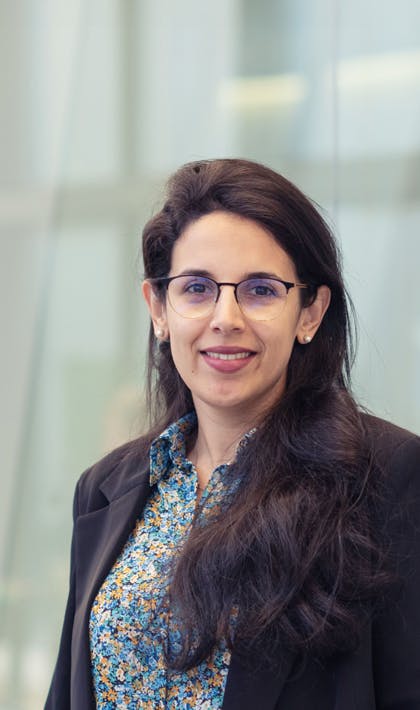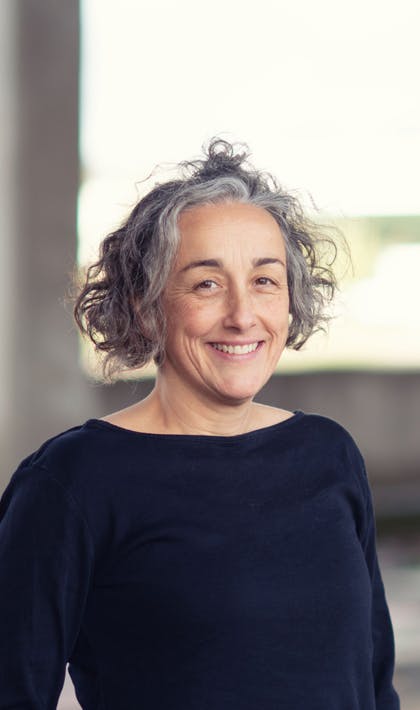Echoes across continents
Nouha was born in Zaghouan, and mostly lived in Nabeul in Tunisia. After getting her engineering degree from the capital, Tunis, she came to Belgium in 2013 to pursue a PhD at KU Leuven in partnership with imec. In 2018, Nouha started working at imec as a research and development engineer at the electrochemical storage group. Today, she serves as an R&D team leader for the 3D and silicon photonics technology department and resides in Wavre, Belgium.



Threads of connection
Belgium was not part of Nouha’s original relocation plan. However, a lucky scholarship redirected her to Belgium in 2013, and she immediately fell in love with the country. She started feeling connected to the Belgian culture due to striking resemblances between Tunisia and Belgium. Both nations share the French language, exhibit a similar bureaucratic affinity, and adhere to comparable work styles. The urban rhythms of Leuven and Wavre resonate with her life back in the city of Tunis. Crucially, both cultures prioritize familial bonds, cherishing extended family gatherings. Nouha has close ties with her family, cousins, and friends in Tunisia. Tunisia being only a two-hours flight far from Belgium, it never felt far for her.
She fondly recalls how her grandmother had olive fields and used to give homemade olive oil on special occasions, which is a common custom in Tunisia. In fact, the olive tree is deeply ingrained in the country’s culture, history, and economy. Tunisia is one of the world’s leading producers of olive oil, and the olive sector contributes significantly to agricultural exports.




Theatrical narratives to Chichkhan heritage
Tunisia has a long-standing history of storytelling, and traditional performances like Malouf and Hadhra are deeply rooted in cultural and religious practices. Alongside the classics, modern Tunisian theater has thrived, tackling social and political issues with diverse styles and themes. Living in Tunis, Nouha enjoyed the lively theater scene during her graduation years. Tunisia at large showcases a variety of productions, from classic plays to cutting-edge performances. The Carthage Theater Days festival, held annually, is a major event bringing together local and international artists, and promoting cultural exchange and collaboration.
Transitioning from the stage to Chichkhan jewelry reveals another aspect of Tunisia’s rich heritage. The Chichkhan style is an intricate blend of Arab, Berber, and Andalusian influences, evident in its intricate filigree work and geometric patterns that showcase exceptional craftsmanship. Often worn during special occasions, these pieces symbolize cultural identity and social status for women. Beyond their beauty, Chichkhan pieces serve a practical purpose, acting as investments and providing financial security for women.
Food tip
Dive into the street food scene in Tunisia, try Kafteji and Fricassee. They are bursting with delicious flavors and give an authentic taste of the country’s diverse cuisine.


Seaside serenity and ancient marvels
Tunisia is a fantastic journey filled with history, culture, and beautiful sights. Nabeul, Nouha’s hometown, is the perfect start, with its golden sands and clear waters along the Mediterranean Sea. It is a popular spot for chilling out and enjoying water activities.
Steeped in Tunisia’s artistic and literary heritage, Sidi Bou Said is a picturesque coastal village with charming cobblestone streets and iconic white wall blue door buildings overlooking the sea. The colors of Bougainvillea against the white walls make it a gorgeous place and comes highly recommended by Nouha.
Near the capital of Tunisia, Carthage, is deep in history, offering ancient ruins and archaeological sites like the Baths of Antoninus, the Carthage Museum, and the Carthage Amphitheater. This UNESCO world heritage site is technically a journey through Punic and Roman civilizations. The town also houses a hidden gem of Tunisia. The Zaghouan Aqueduct shines brightly, highlighting ancient Roman engineering amidst olive groves and hills.
It was used to transport the famous high-quality water from Zaghouan mountains to the ancient Carthage, covering a total distance of approximately 81 miles.
Speaking of hidden gems, another well-kept secret is the El Jem amphitheater, a colossal Roman arena that is remarkably well preserved in the city of El Jem. All these sites are a poignant reminder of Tunisia’s history and how it blended natural beauty with architectural brilliance.
Every stop in the journey through Tunisia adds to its story, creating a place where history and the present blend together harmoniously.







